Serviços Personalizados
Journal
Artigo
Indicadores
-
 Citado por SciELO
Citado por SciELO -
 Acessos
Acessos
Links relacionados
-
 Similares em
SciELO
Similares em
SciELO
Compartilhar
Revista de Ciências Agrárias
versão impressa ISSN 0871-018X
Rev. de Ciências Agrárias vol.42 no.1 Lisboa mar. 2019
https://doi.org/10.19084/RCA18287
ARTIGO
Relation of milling process and physiological quality of rice seeds during storage
Relação qualidade de moagem e qualidade fisiológica de sementes de arroz durante o armazenamento
Juliana Maria Espíndola Lima1,*, Oscar José Smiderle2, Lindemberg de Matos Galvão3, Allex Ricarte de Sá3 and Antônio Carlos Centeno Cordeiro2
1 Agriculture department/ Seed sector, Federal University of Lavras, Lavras, Brazil
2 Seed Laboratory, Embrapa Roraima, Boa Vista, Brazil
3 Agriculture department, Federal University of Roraima, Boa Vista, Brazil
(*E-mail: espindolaj5@hotmail.com)
ABSTRACT
Rice (Oryza sativa L.) is one of the most widely grown crops in the world and one of the earliest domesticated crop species. Also, its consumption is around 20% of the worlds caloric intake. It was aimed in this study to evaluate the relation between milled rice yield and physiological quality of rice seeds during storage. Two experiments were carried out with seeds of long-fine common rice and special rice cultivars. The storage evaluations were made at 0, 30, 60, 90 and 120 days. The experimental design was completely randomized with 3 x 5 factorial (cultivars x storage) for each experiment, with four replicates. The performed tests were: Milled rice yield, weight of one thousand seeds, germination, first count of germination and electrical conductivity. The special rice cultivars BRS 358 and ´Jasmine, as well as the common rice cultivars Sinuelo and Jaçanã, have greater potential for seed physiological quality and milled rice yield. The physical quality for milling process is linked to the physiological quality of the six cultivars tested..
Keywords: Oryza sativa L., dormancy, germination, grains
RESUMO
O arroz (Oryza sativa L.) é uma das culturas mais cultivadas no mundo e uma das primeiras espécies de culturas domesticadas. Além disso, o seu consumo representa cerca de 20% da ingestão calórica do mundo. Objetivou-se neste estudo avaliar a relação entre a qualidade de moagem e a qualidade fisiológica de sementes de arroz durante o armazenamento. Foram realizados dois ensaios com sementes de 3 cultivares de arroz comum tipo longo-fino e 3 cultivares especiais de arroz. As avaliações de armazenamento foram realizadas aos 0, 30, 60, 90 e 120 dias. O delineamento experimental foi inteiramente casualizado com fatorial 3 x 5 (cultivares x armazenamento) para cada ensaio, com quatro repetições. Os testes realizados foram: qualidade de moagem, peso de mil sementes, germinação, primeira contagem de germinação e condutividade elétrica. As cultivares especiais de arroz BRS 358 e ´Jasmine, bem como as cultivares comuns de arroz, Sinuelo e Jaçanã, apresentam maior potencial para qualidade fisiológica e qualidade de moagem. A qualidade física do processo de moagem está vinculada à qualidade fisiológica das sementes da seis cultivares de arroz testadas.
Palavras-chave: Oryza sativa L., dormência, germinação, grão.
INTRODUCTION
Rice (Oryza sativa L.) is one of the most widely grown crops in the world and one of the earliest domesticated crop species. Also, its consumption is around 20% of the worlds caloric intake; Asian countries consume 50% of rice, which represents half of the world population (Agrama et al., 2010; FAO, 2005). Besides Asia, rice is part of developing countries diet and the staple food of more than half of the worlds population, more than 3.5 billion people depend on rice for their daily calorie intake (IRRI et al., 2010).
White rice comes from milling rough rice that is usually done at about 14% of moisture content due to consumer preference. Economically the price of the rice is strongly related to the kernel size and shape, whiteness and cleanliness (Conway et al., 1991).
All these factors are closely related to the milling process, where rough rice is primarily subjected to dehusking or removal of hulls and then removal of the brownish outer bran layer that is known as whitening. To finalize, a polishing is made to remove bran particles and give a gloss surface to the kernels. For the millers, having a high percentage of broken kernels after the milling represents economically a direct loss to their production. These losses during milling depend on the variety and content of rough rice, the degree of milling required, the kind of rice mill used and the operators (Yadav and Jindal, 2001).
Rice kernels with three quarters or more of their original length after complete milling operation are classified as head rice. The price of head rice is almost double or triple as compared to that of the broken kernels. Hence, maximizing the proportion of head rice with the desired degree of kernel whiteness is the priority for the rice milling industry (Yadav and Jindal, 2008). The typical maximum of milled rice yield is 65% to 75% and the maximum of head yield rice is 55% to 65% (Thompson et al., 1990).
Most of the cultivars present a reduction in the milled rice yield after a certain degree of maturation, in which kernels with low water content are likely to be harvested and processing (Faroni et al., 1987). Therefore, the harvesting season is fundamental for obtaining a quality product with high yield. When the harvest is anticipated and the kernels have high water content, there is an increase in the proportion of malformed and plaster kernels. When late harvesting occurs with low grain moisture content, yield is affected by dehiscence, fissuring, and reduction of milled rice yield after milling (Smiderle and Pereira, 2008).
Many researchers have focused on improving milling quality through plant breeding programs, improved cultural practices and optimization of harvesting and drying conditions (Gravois, 1998; Abud-Archila et al., 2000; Dong et al., 2003; A-Bond and Bollich, 2007). Otherwise, no research was found about the correlation between physiological quality of rice seeds and milled rice yield. Seed harvested for continued rice production may require different physiological and/or chemical characteristics as compared to seed harvested for milling, and because of that most available literature is published separated.
Seed rice has a dormancy that is broken after a period of storage. Mikkelsen (1967) and Takahashi (1967) indicated that rice is not true embryo dormancy, since embryos when excised from dormant seed germinate freely. Seshu and Sorrells (1986) affirmed that the hull and the pericarp act independently in imposing dormancy in rice seeds, considering the hull a predominant dormancy factor.
Also a number of physical or chemical factors can be responsible for arresting germination as the non-availability of oxygen to the embryo caused by the hull and the pericarp impermeability, or high peroxidase activity, and the occurrence of growth inhibitors such as abscisic acid, and phenols in the covering structures as well as in the embryo, or short-chain saturated fatty acids, could be considered possible reasons for seed dormancy in rice seed (Roberts, 1961; Mikkelsen, 1967; Takahashi, 1967; Navasero et al., 1975; Hayashi, 1987; Majumder et al., 1989).
The increase in the yield of head rice following a storage period, cited by technicians of the Cooperativa Mista Rural Vale do Javaés – Coperjava in Castro et al. (1999) would be due to the lower adhesion of the endosperm of the seeds to the bark as the storage proceeds, which facilitate the removal during the debarking. The same authors also affirm that the storage of the seeds before the milling process contributes to decrease the rate of grain break and to increase the working efficiency with less wear of the used appliances, besides better cooking.
The effect of storage time on appraisal physical and physiological quality in rice seeds is still not clear, and because of that, it was aimed in this study to evaluate the relation between milled rice yield and physiological quality of rice seeds during storage.
MATERIAL AND METHODS
The seed used in the experiment was produced at Fazenda Santa Cecília, in a meadow area of Rio Branco, located in Cantá city of Roraima state (2°48'27'484 "N and 60°39'17'564" W) during the period of December 2013 to April 2014. The type of soil was Gleysoil Haplic Tb Distrophic, with the following chemical and physical characteristics: pH = 5.1; MW = 30.92; P = 12.12 mg dm-3; K = 0.21 cmolc dm-3; Mg = 0.38 cmolc dm-3; Ca = 1.25 cmolc dm-3; Silt = 468.6 g kg-1; Sand = 278.5 g kg-1; Clay = 252.9 g kg-1.
Three special rice Oryza sativa L cultivars – BRS 358 (japonic), Formosa (aromatic) and Jasmine (japonic) were produced in a randomized complete block design with four replicates, and three long-fine common rice Oryza sativa L cultivars - Jaçanã, Sinuelo, and Tropical were produced using the same design in the same field as the special rice cultivars. The experimental plot consisted of eight rows of five meters in length, with spacing between rows of 0.25 m; the useful area corresponded to six central lines, being discarded 0.50 m at the ends. The soil when dry was prepared by performing a plowing with a harrow, two leveling harrows, followed by the construction of the tails. Fertilizers as 120 kg ha-1 of P2O5 (simple superphosphate with, 20% of P2O5) and 90 kg ha-1 of K2O (source: potassium chloride with 60% K2O) were used.
Weed control was performed in the pre-emergence and after sowing, with the application of the equivalent of 1.0 kg of a.i. ha-1 of oxadiazon (Ronstar® 250 BR) in the form of spraying via soil with humidity close to saturation, according to Cordeiro et al. (2009).
Harvesting was carried out after physiological maturity was achieved, with the central 4 m of the center six rows of each plot being harvested. The seeds of each cultivar were homogenized and dried at 40 °C for 48 to 72 hours until they reached a moisture content of around 13% and were stored for three days to balance the moisture content of the seeds. Then the seeds of each cultivar of special and common rice were placed in paper bags for each evaluation period and stored at 25 °C ± 1 with a relative humidity of approximately 60%, the storage evaluations were performed at 0, 30, 60, 90 and 120 days.
For the laboratory evaluations, an experimental design was used as completely randomized with a factorial 3 x 5 (cultivars x storage) for each rice type (special rice and common rice), with four replications. The evaluations carried out in each period were.
Milled rice yield: it was determined by dehusking four replicates of 100 g of rough rice per cultivar in each period, with a "Suzuki" dehusk machine. The rough rice was milled and separated for 30 seconds to obtain the whole and broken kernels and hull, and then the whole kernels were polished for 60 seconds and separated again for 30 seconds in whole and broken kernels, obtaining, in the end, the proportion in grams of polished kernels (head rice), broken kernels and hull.
Weight of one thousand seeds: eight replicates of 100 pure seeds of each cultivar were used, and then weighed in a 0.001 g precision scale; we calculated the weight of one thousand seeds according to the Rules for Seed Analysis (Brasil, 2009).
Germination (%): Paper substrate was moistened with distilled water 2.5 times the dry paper weight. For each sample in question, four replicates were used with 50 seeds each, kept in germinator at 25 °C. Germination was evaluated 14 days after sowing, and the number of hard seeds (dormant) was also determined (Brazil, 2009).
First count of germination (%): This evaluation was conducted in conjunction with the germination test. The number of normal seedlings was counted on the fifth day after sowing (Brazil, 2009).
Electrical conductivity (μS cm-1g-1 of seed): four replicates of 50 seeds for each cultivar were used, weighed in a 0.001 g precision scale and placed in plastic cups containing 75 mL of distilled water for 24 hours, at a temperature of 25 °C. The electrical conductivity readings were performed 24 hours after seed imbibition with a digital conductivity meter (Kryzanowski et al., 1999).
The results obtained from the evaluation periods of each cultivar from both experiments were submitted to the analysis of variance and the means comparison, with significance level at 5%, by the Tukey test, and for the regression analysis it was considerate the R2 (coefficient of determination) and the significance of 1% probability for t-test, we used the SISVAR software to do the statistics (Ferreira, 2011).
RESULTS AND DISCUSSION
The analysis of the mean squares shows a significant interaction between the factors variation studied in the two experiments (Table 1), which suggests the effect of storage environment on seed quality varied among the cultivars.
The milled rice yield data for the special rice cultivars (Figure 1A) had initial (zero-day) yields of 57%, 49%, and 40% and final (120 days), 72%, 72%, and 53% yield, for BRS 358, Formosa and ´Jasmine, respectively. In the common rice cultivars (Figure 1B) the increase in yield during storage was observed, which the cultivar Jaçanã showed the highest yield compared to the other cultivars, with a total of 64% of milled rice yield at the end of 120 days, though Tropical and Sinuelo had 56% and 57%, respectively.
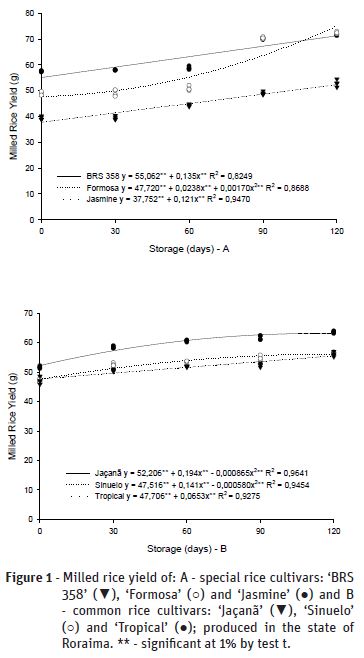
The increase in the yield of milled rice during storage, cited by technicians of the Cooperativa Mista Rural Vale do Javaés – Coperjava in Castro et al. (1999) would be due to the lower adhesion of the endosperm of the seeds to the hull as the storage proceeds, which facilitate the removal during the dehusking. The same authors also stated that the storage of the seeds before the milling process contributes to decrease the rate of broken kernels and to increase the working efficiency with less wear of the used appliances, besides better cooking.
Thus, the storage period for special rice cultivars BRS 358 and Formosa and the common rice cultivar Jaçanã tended to increase a higher yield of head rice when compared to the other cultivars (Figure 1A, B).
In the percentage of broken kernels of the special rice cultivars (Figure 2A), there was a lower breakage of the Formosa cultivar (3%) at the end of the storage period, otherwise, in the begging of the storage, it had 25% of broken kernels. The cultivar BRS 358 had the lowest yield (15%) at the beginning of storage and fell to 8% yield at 120 days. Considering the yield of broken kernel of the common rice cultivars, it was observed that the cultivar Tropical (Figure 2B) had the smallest reduction in the broken kernel along with the storage, with an initial mean (zero days) of 19% and final (120 days) of 13%. While the cultivars Jaçanã and Sinuelo had the largest reduction, with a percentage of broken kernels at zero days of 16% and 13% and at 120 days of 6% and 8%, respectively.
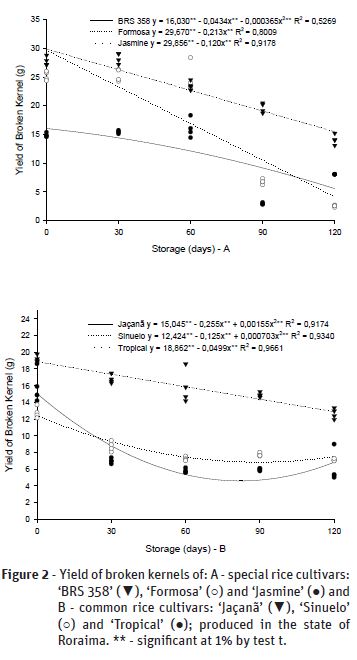
The correct harvesting time is fundamental for better quality seeds and higher yields, early or late harvesting may increase kernel breakage in crop yield due to the presence of malformed kernel (early harvest) or low kernel water content causing cracking (late harvest) (Smiderle et al., 2008). At the Brazilian national level of broken kernel the percentage after polishing is around 28% (Vieira and Carvalho, 1999), and in the cultivars studied in this work, yields of broken kernel were obtained below this level.
The potential of crop yield observed in common and special rice cultivars produced in the state of Roraima , presented promising data, especially for the cultivation of special rice, with head rice (BRS 358 and Formosa) above the national mean.
The data obtained for a thousand seed weight had significant variations throughout the storage for all special and common rice cultivars, being observed weight loss in the periods of 30, 60 and 90 days and a slight increase at 120 days, but this increase was lower than the initial weight. This oscillation in weight may have contributed to the increase of the milled rice yield since the reduction of the size could facilitate the detachment of the endosperm within the hull.
The mean weight of one thousand seeds during storage was 22.3g, 26.8g, and 31.3g for BRS 358, Formosa and ´Jasmine (Figure 3A), and 26.9g, 28.7g and 29.3g for Jaçanã, Sinuelo and Tropical (Figure 3B), respectively, in zero days. At 120 days it was 21.8g, 26.1g and 31.3g for BRS 358, Formosa and ´Jasmine and 26.4g, 27.6g and 29.1g for Jaçanã, Sinuelo, and Tropical, respectively.
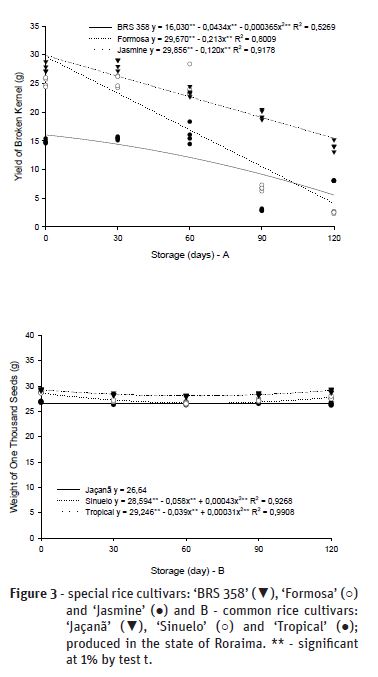
Together with the good physical quality of the kernels for the milled rice yield, comes the physiological quality that will bring information about the potential of the cultivars to present uniform stand of plants and vigor. For Souza et al. (2007) seed quality is important for the establishment of the population in the field, development, and production. However, rice cultivation is still considered a byproduct in Brazil, in contrast to well established crops such as soybeans. These same authors also affirmed that the main product of rice is the head rice, and the obtaining of seeds with physiological quality is of paramount importance to guarantee a high standard of kernel productivity and quality.
In determining physiological quality, it was observed in the first count of germination at zero days of storage that for special rice cultivars (Figure 4A) the lowest result was for seeds of the cultivar Formosa (39%), while the others were at 60% germination. The common rice cultivars had percentages below 50% (Figure 4B), and the cultivar Tropical being the lowest percentages of 7%.
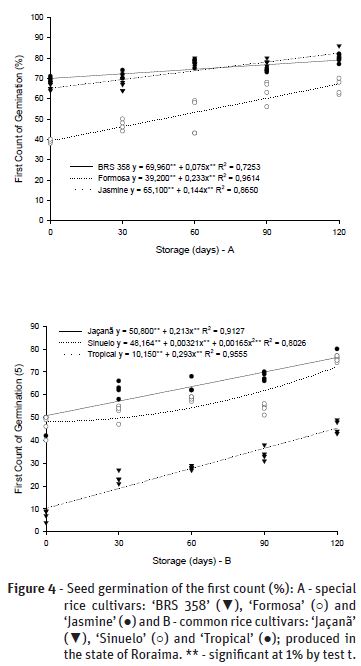
As the storage period increased, seed germination increased, characterizing the overcoming of dormancy over time. At 120 days the cultivars BRS 358 and ´Jasmine (Figure 4A) and the cultivars Sinuelo and Jaçanã (Figure 4B) exhibited the greatest germination rate (above 75%).
This lower initial germination percentage shows the dormancy present in the cultivars of the two experiments. This is in accordance with Bewley and Black (1994) which stated that rice seeds may have a temporary germination suspension even when the seeds are in favorable conditions for germination and are therefore considered seeds dormant.
The storage duration also increased the final count of seed germination in both experiments, with cultivars BRS 358 (86%) and ´Jasmine (87%) (Figure 5A) showing the highest germination increment storage period (120 days). The same was observed in the cultivars Jaçanã and Sinuelo (Figure 5B) in which they presented higher germination at the end of storage (83% and 79%) compared to Tropical. In both experiments, the cultivars mentioned above were the ones that had lower dormancy from the beginning to the end of the storage.
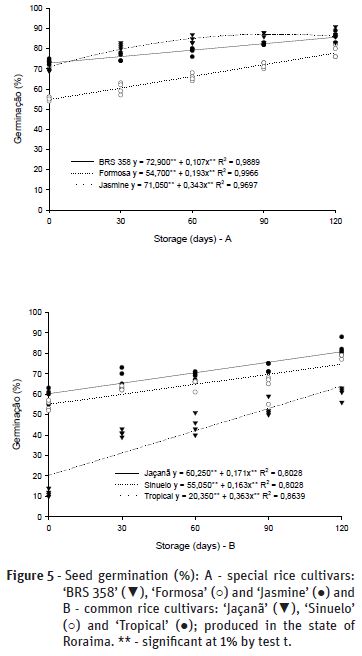
According to Amaral (1992), there are several causes of dormancy in rice seed genotypes, among them temperature and humidity are the ones that most influence the occurrence of dormancy. Low temperatures at the beginning of maturation and high temperatures at 10 to 15 days after flowering could induce seed dormancy. Additionally, the interaction of elevated temperatures after flowering with the presence of inhibitors and the restriction absorption of O2 by the hull-pericarp complex, also determine dormancy in rice.
The percentage of hard seeds (Figure 6) was directly related to the germination, in which due to the dormancy present in the seeds, the percentage is higher at the beginning of storage and reduced as dormancy is exceeded. This confirms the presence and level of dormancy of the seeds in both experiments and among the cultivars studied. The cultivars Formosa (Figure 6A) and Tropical (Figure 6B) presented a higher percentage of hard dormant seeds throughout the storage.
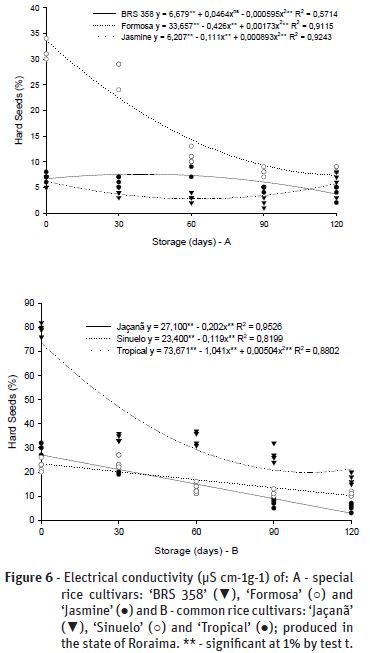
The results obtained for the electrical conductivity of the special rice seeds cultivars had values significantly lower at 120 days, in relation to the zero days (Figure 7A). This reduction may be indicative of seed germination vigor increasing during storage. At zero days the conductivity was 15.80, 20.79 e 14.09 µS cm-1g-1 and 14.13, 18.07 e 11.60 µS cm-1g-1 for the cultivars BRS 358, Formosa, ´Jasmine, respectively. However, data obtained from seeds of common rice cultivars (Figure 7B) had significant results, lower at the beginning of storage and higher at the end with oscillations during the period, and the test was not efficient to detect the increase of vigor as observed in the first experiment (Figure 7A). At zero days the conductivity was 12.65, 11.42 and 11.78 μS cm-1g-1 and in 120 days 15.69, 12.61 and 12.71 μS cm-1g-1 for the cultivars Jaçanã, Sinuelo, and Tropical, respectively.

In rice cultivation, dormancy is understood as a resistance to germination in pre and post-harvest (Foley and Fennimore, 1998), related to the levels of seed maturation, by exposure to environmental conditions present between the maturation and harvest stage. Therefore, it is possible to occur a dormancy variation between cultivars, lots and harvests, varying from 11 weeks after harvest to 120 days after the beginning of storage (Amaral and Gonçalo, 1977).
Based on the results obtained in both physical and physiological quality tests, it was possible to verify that the quality of the seeds of special and common rice are directly related. These results suggest a seed physiological test (such as a germination test) may be a useful indicator for the producers about when is the best time to mill rice to maximize yield, because loss of dormancy that indicates the hull adhesion to the seed is lost, what facilitate milling process. The better the seed physiological quality the better the kernels for the milling process.
CONCLUSIONS
The special rice cultivars BRS 358 and ´Jasmine, as well as the common rice cultivars Sinuelo and Jaçanã, have greater potential for seed physiological quality and milled rice yield.
The physical quality for milling process is linked to the physiological quality of the seeds of special rice (BRS 358, Formosa and ´Jasmine) and common rice (Jaçanã, Sinuelo, and Tropical).
Both the special rice and the common rice cultivars need a period of storage to overcome dormancy, improve milled rice yield, and enhance physiological quality.
References
A-bond, J. & Bollich, P.K. (2007) - Effect of pre-harvest desiccants on rice yield and quality. Crop Protection, vol. 26, n. 4, p. 490-494. https://doi.org/10.1016/j.cropro.2006.02.01. [ Links ]
Abud-Archila, M.; Courtois, F.; Bonazzi, C. & Bimbenet, J.J. (2000) - Processing quality of rough rice during drying – Modeling of head rice yield versus moisture gradients and kernel temperature. Journal of Food Engineering, vol. 45, n. 3, p. 161-169. https://doi.org/10.1016/S0260-8774(00)00057. [ Links ]
Agrama, H.A.; Yan, W.; Jia, M.; Fjellstrom, R. & Mcclung, A.M. (2010) - Genetic structure associated with diversity and geographic distribution in the USDA rice world collection. Natural Science, vol. 2, n. 4, p. 247-291. https://doi.org/10.4236/ns.2010.24036 [ Links ]
Amaral, A.S. (1992) - Aspectos da dormência em sementes de arroz. Lavoura arrozeira, vol. 45, n. 405, p. 3-6. [ Links ]
Amaral, A.S. & Gonçalo, J.F.P. (1977) - Dormência em sementes de arroz. Lavoura Arrozeira, vol. 30, n. 301, p. 35-37. [ Links ]
Bewley, J.D. & Black, M. (1994) - Seeds: physiology of development and germination. 2.ed. New York, Plenum Press, 445 p. [ Links ]
Brasil (2009) - Regras para análise de sementes. Brasília, Mapa/ACS. Ministério da Agricultura, Pecuária e Abastecimento. 399 p.
Castro, E.M.; Vieira, N.R.A.; Rabelo, R.R. & Silva, S.A. (1999) - Qualidade de grãos em arroz. Santo Antônio de Goiás, Embrapa Arroz e Feijão, 30p. (Embrapa Arroz e Feijão. Circular Técnica, 34). [ Links ]
Conway, J.A.; Sidik, M. & Halid, H. (1991) - Quality/value relationships in milled rice stored in conventional warehouses in Indonesia. In: Proceedings of the fourteenth ASEAN Seminar on Grain Postharvest Technology, Manila, Philippines, p. 55-82. [ Links ]
Cordeiro, A.C.C.; Medeiros, R.D.; Marsaro Júnior, A.L. & Nechet, K.L. (2009) - Recomendações técnicas para o cultivo do arroz irrigado em várzeas de Roraima. Boa Vista, Embrapa Roraima, 19 p. (Embrapa Roraima. Circular Técnica, 06). [ Links ]
Dong, Y.; Tsuzuki, E.; Lin, D.; Kamiunten, H.; Terao, H. & Matsuo, M. (2003) - Molecular genetic mapping of quantitative trait loci for milling quality in rice (Oryza sativa L.). Journal of Cereal Science, vol. 40, n. 2, p.109-114. https://doi.org/10.1016/j.jcs.2004.04.00. [ Links ]
FAO (2005) - FAOSTAT data. <http://faostat.fao.org/site/346/DesktopDefault.aspx?PageID=346> [ Links ].
Faroni, L.R.D.; Hara, T.; Dalpasquale, V.A. & Condé, A.R. (1987) - Determinação de rendimento do arroz (cultivar IR 841) após secagem às temperaturas de 50, 60 e 70°C, para períodos de repouso de 30, 60, 120 e 180 minutos. Revista Brasileira de Armazenamento, vol. 11-12, n. 1-2, p. 26-31. [ Links ]
Ferreira, D.F. (2011) - Sisvar: a computer statistical analysis system. Ciência e Agrotecnologia, vol. 35, n. 6, p. 1039-1042. http://dx.doi.org/10.1590/S1413-70542011000600001 [ Links ]
Foley, M.E. & Fennimore, S.A. (1998) - Genetic basis for seed dormancy. Seed Science Research, vol. 8, n. 2, p.173-182. https://doi.org/10.1017/S0960258500004086 [ Links ]
Gravois, K.A. (1998) - Optimizing selection for rough rice yield, head rice, and total milled rice. Euphytica, vol. 101, n. 2, p. 151-156. https://doi.org/10.1023/A:1018331809955 [ Links ]
Hayashi, M. (1987) - Relationship between endogenous germination inhibitors and dormancy in rice seeds. Japan Agricultural Research Quarterly vol. 21, n. 1, p. 153-161. [ Links ]
IRRI, AfricaRice & CIAT (2010) - Global Rice Science Partnership (GRiSP). November 2010. [ Links ]
Krzyzanowski, F.C.; Vieira, R.D. & França Neto, J.B. (1998) - Vigor de sementes: conceitos e teste. Ed. Abrates, Londrina, 218 p. [ Links ]
Majumder, M.K.; Seshu, D.V. & Shenoy, V.V. (1989) - A biochemical screening technique for cold tolerance in rice. Crop Science, vol. 29, n. 5, p. 1298-1304. [ Links ]
Mikkelsen, D.S. (1967) - Germination inhibitors as a possible factor in rice dormancy. International Rice Commission Newsletter (Special Issue), p. 132-145. [ Links ]
Navasero, E.P.; Baun, L.C. & Juliano, B.O. (1975) - Grain dormancy, peroxidase activity and oxygen uptake in Oryza sativa. Phytochemistry, vol. 14, n. 9, p. 1899-1902. https://doi.org/10.1016/0031-9422(75)83092. [ Links ]
Roberts, E. H. (1961) - Dormancy of rice seed. I. Distribution of dormancy periods. Journal of Experimental Botany, vol. 12, n. 2, p. 319-329. https://doi.org/10.1093/jxb/12.2.31. [ Links ]
Seshu, D.V. & Sorrells, M.E. (1986) - Genetic studies on seed dormancy in rice, In: Rice genetics. Los Banos, Philippines, International Rice Research Institute. 369-384 p. [ Links ]
Smiderle, O.J. & Pereira, P.R.V.S. (2008) - Épocas de colheita e qualidade fisiológica das sementes de arroz irrigado cultivar BRS 7 TAIM, em Roraima. Revista Brasileira de Sementes, vol. 30, n. 1, p. 74-80. http://dx.doi.org/10.1590/S0101-31222008000100010 [ Links ]
Souza, L.C.D.; Yamashita, O.M. & Carvalho, M.A.C. (2007) - Qualidade de sementes de arroz utilizadas no norte de Mato Grosso. Revista Brasileira de Sementes, vol. 29, n. 2, p. 223-228. http://dx.doi.org/10.1590/S0101-31222007000200029 [ Links ]
Takahashi, N. (1967) - Dormancy and germination of rice seeds with respect to germination inhibitors. Bulletin Institute of Agricultural Research Japan, vol. 18, n. 1, p. 195-213. [ Links ]
Thompson, J.F.; Knutson, J. & Jenkins, B. (1990) - Analysis of variability in rice milling appraisals. American Society of Agricultural Engineers, vol. 6, n. 2, p. 194-198. https://doi.org/10.13031/2013.26370 [ Links ]
Vieira, N.R.A. & Carvalho, J.L.V. (1999) - Qualidade tecnológica. In: Vieira, N.R.A. et al. (Eds.) - A cultura do arroz no Brasil. Santo Antônio de Goiás, Embrapa Arroz e Feijão, p. 582-604. [ Links ]
Yadav, B.K. & Jindal, V.K. (2001) - Monitoring milling quality of rice by image analysis. Computers and Electronics in Agriculture, vol. 33, n. 1, p. 19-33. https://doi.org/10.1016/S0168-1699(01)00169. [ Links ]
Yadav, B.K. & Jindal, V.K. (2008) - Changes in head rice yield and whiteness during milling of rough rice (Oryza sativa L.). Journal of Food Engineering, vol. 86, n. 1, p. 113–121. https://doi.org/10.1016/j.jfoodeng.2007.09.025 [ Links ]
Received/recebido: 2018.09.26
Received in revised form/recebido em versão revista: 2018.10.23
Accepted/aceite: 2018.10.23














